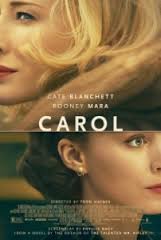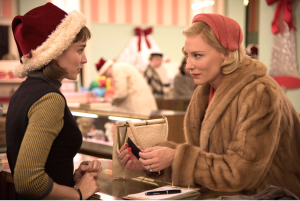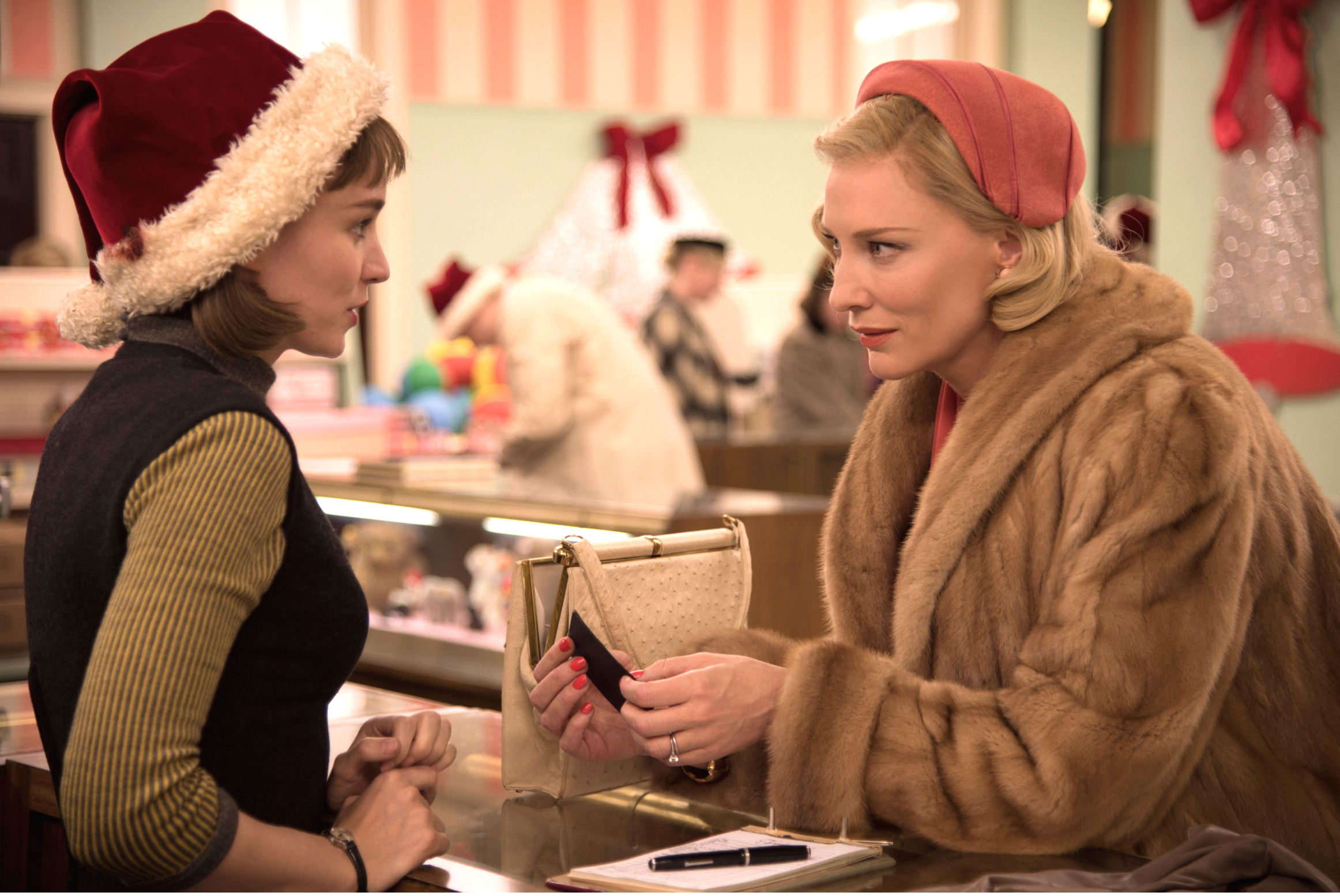 Carol
Carol
Directed by Todd Haynes
The Weinstein Company
THE BEST WAY to measure the spark in any romantic relationship is to see whether a person’s face lights up when their beloved enters a room. A glimmer in the eye or even the faintest smile is all it takes. This explains why, in Todd Haynes’ latest film, Carol, the faces of the titular New Jersey housewife and that of her younger lover, Therese, appear slightly queasy, even despairing, when their husband or boyfriend enters the room. With the exception of a road trip that allows Carol (played by Cate Blanchett) and Therese (Rooney Mara) to escape the conservative constraints of postwar New York, the film’s action is set in Manhattan, which in 1952 was not so much a paradise of unfettered freedom as it was a prison for women forced to live, as Carol puts it, “against [their]grain.”
The first image in Carol is that of a subway grate. Seen up close, it resembles both a baroque tapestry and the gilded bars of a birdcage. What follows is every bit as visually stimulating, and, with compelling performances to complement cinematographer Edward Lachman’s gorgeous camerawork and Haynes’ exacting directorial style, Carol is a powerful portrait of same-sex lovers living in the shadows of the American dream. The source material for the film is a classic work of lesbian pulp: a Patricia Highsmith novel called The Price of Salt, published pseudonymously (complete with a fake dedication page) under the name Claire Morgan in 1952. One year earlier, Alfred Hitchcock adapted the novelist’s debut work Strangers on a Train to the silver screen—a book rife with homosexual subtext, as is Highsmith’s later murder mystery The Talented Mister Ripley.
The Price of Salt, for its part, is a slyly lesbian romance in which Highsmith uses the youth and innocence of Therese, and her schoolgirl crush on an older woman, to question the dominant heterosexual culture of the 1950s. In a jaw-dropping scene torn from Highsmith’s pages, Therese asks her boyfriend Richard if he ever loved another boy and whether he believes “two men or two girls” can fall in love, asking “Do you think I could?” Later, once she’s fully aware of her love for an older woman, Therese muses: “She thought of people she had seen holding hands in the movies, and why shouldn’t she and Carol?”
In 1990, five years before her death at 74, Highsmith finally owned up to authoring the work. In adapting it for the screen, Phyllis Nagy has dislodged this tale of forbidden love from the first-person perspective of the naïve Therese, shedding a light on Carol Aird’s affluent existence as a mother who is divorcing her husband Harge (Kyle Chandler)—a good provider who’s handsome enough—ostensibly because she can only love women.

At the film’s start, it’s Christmastime in the city, and Therese is working at a department store called Frankenberg’s, where she waits on Carol and is immediately taken with her intense beauty: the Streep-like cheek bones, fur coat, pink pillbox hat with fingernails to match. “Shopping makes me nervous,” confesses Carol, to which a mooning Therese replies, “Working here makes me nervous.” Carol leaves her gloves behind and, from there, the plot is relatively simple: girl meets girl, girl loses girl when Carol’s husband hires a private detective to expose her “perversion” (a ploy to keep custody of their daughter), and … you know the rest.
Blanchett and Mara display a palpable chemistry whenever they’re together. Haynes relies upon that age-old cinematic device, the gaze, to communicate their instant attraction. Nagy’s script also turns on the unspoken gesture as a way to communicate forbidden desire. This is, after all, the height of the McCarthy era in American politics and culture. Homosexuals are “people like that”; Carol’s husband refers with disgust to “a woman like you.” All closeted people are performers of some kind, which means that Mara and Blanchett are both actresses playing actresses. Their love scene, after a protracted build-up, is intensely passionate (and surprisingly explicit) in keeping with Highsmith’s prose. “She was conscious of Carol and nothing else,” reads one characteristic passage. “Carol’s hair that brushed her bare breasts, and then her body too seemed to vanish in widening circles that leaped further and further, beyond where thought could follow.”
The plight of the suburban female has long fascinated Todd Haynes, who began his directorial career with the curiosity Safe (1995), a film about another woman named Carol, played by Julianne Moore, a neurotic Los Angelina who, increasingly allergic to her environment, retreats to the desert and withdraws completely from what she fears is toxic modernity. In Far From Heaven (2002), with Moore again in the starring role, Haynes hewed closely to the 1950s ideal of the “perfect family,” only this time Moore’s character was secretly longing for her African-American gardener while her alcoholic husband (Dennis Quaid), was sneaking out to gay bars and unraveling from the trauma of conversion therapy. Carol is a kind of mirror image of Far From Heaven in depicting the trapped existence of gay people in loveless heterosexual marriages, but from the lesbian perspective. (Haynes’ previous project, an ambitious multi-part remake of Mildred Pierce, confirmed him as Hollywood’s high priest of period décor.)
Haynes’ adaptation of Highsmith’s novel asks that we consider the quiet heroism of women like Carol and Therese who, far from taking to the streets with protest signs, served to change society through the pursuit of their own happiness. It is Highsmith, however, who challenged the stereotypes surrounding woman-oriented women as early as 1952. “She had heard about girls falling in love, and she knew what kind of people they were and what they looked like,” she wrote in The Price of Salt, but “neither she nor Carol looked like that.” One thinks again of that first image in the movie: the grimy but lovely subway grate, and then of one of Saint Oscar’s most often quoted epigrams: “We are all in the gutter, but some of us are looking at the stars.”
Colin Carman, PhD, teaches British literature at Colorado Mesa University. An essay of his will appear in the forthcoming book collection Romantic Ecocriticism (Lexington Books).






